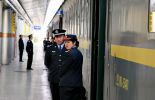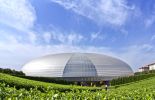Related Links
|
|
|
|
|



Enjoy the comfort and easy pace of train travel. As we journey across beautiful landscapes and varied terrain, you will experience the diversity of this enormous country and have plenty of opportunities to get to know your fellow passengers!
Some of the trains we'll be experiencing on this tour include a disused freight train in the 798 Art Distric that used to transport goods produced in the old Bauhaus-style factories. We'll also pay a visit to Beijing's first railway station on the corner of Tiananmen Square which has now been converted to a train museum.
A holiday dedicated to train travel would not be complete without riding the subway in Beijing. Up until 1970 only the military were allowed to use it. We'll ride on a newer version of the subway and get to see some of the old subway stations.
The night trains to Xi'an and Nanjing are very comfortable and saves time on day travel. We'll be in shared compartments with soft sleepers. The bullet train from Nanjing to Shanghai is a high-speed modern train that will get us to Shanghai in just two hours.
If you want to cover a lot of ground and avoid domestic flights, this is the perfect way of experiencing this vast country. Join us on an unforgettable train voyage!
A child is defined as 12 years or younger and below 1.20m in height.
Above are prices based on the period of travel. If the dates don't fit your holiday plans, just get in touch with us and we'll arrange the holiday to accommodate your preferred travel dates.
We reserve the right to make improvements and changes to the itinerary due to local circumstances or events outside our control.
This tour starts in Beijing and ends in Shanghai.
An Albatros Travel representative will meet you at the airport. This tour includes pick-up and departure services. Please let us know your flight details, including flight number, arrival and departure times, in order for us to arrange your transfers.
This tour does not include any strenuous activity so no particular level of ability is required, however please be prepared for some walking. If you have any concerns or questions regarding disability access, please contact us in advance.
If you have any particular dietary preferences or requirements, please make these clear when you make your booking. Most types of diet can be catered for. We will eat at local restaurants. It’s not a problem to maintain a vegetarian diet in China.
Breakfast at the hotel is usually an international breakfast buffet.
In general, tourists do not need any vaccinations. Malaria vaccinations are not necessary in most parts of China. However, we advise you to consult with your doctor before travelling. For more information about health and vaccinations, please look at this website.
Weather in Beijing
Summertime in Beijing is usually charaterised by hot and humid days followed by balmy evenings. Winters are often very cold with temperatures dropping to -10 degrees Celcius (14 degrees Fahrenheit). Spring and autumn are good seasons for visiting China's capital although spring sometimes sees sandstorms caused by the winds blowing dust from the Mongolian steppe.
Baggage
For domestic travel by air, the baggage allowance is 20kg (44lbs) per person. Since we do not provide tours with international air travel, please check your airline's website for luggage weight limits.
Adaptors
Flat two pin outlets are used in China. European round two pin outlets can also be used but don't fit perfectly. A plug adaptor can be purchased in most electronic stores.
Most travellers need a tourist visa to China. Please consult the Chinese consulate or embassy in your country of residence for visa application. This website may be useful in providing information regarding the application procedure.
If you need to cancel
We understand that your travel plans sometimes change and we try to be as flexible as possible. However as we have to book accommodation at hotels we are also bound by their cancellation policies. In general, the following rules will apply when cancelling a tour you have booked:
- If cancelling more than 45 days before commencement of our services there is no cancellation fee and we will refund 100% of your money
- If cancelling within 45 to 31 days before commencement of our services: 20 % of the total booking value will be levied
- If cancelling within 30 to 15 days before commencement of our services: 60 % of the total booking value will be levied
- We are unable to offer a refund if cancelling less than two weeks before commencement of our services
For full details of our cancellation terms, please see our general Terms and Conditions.



